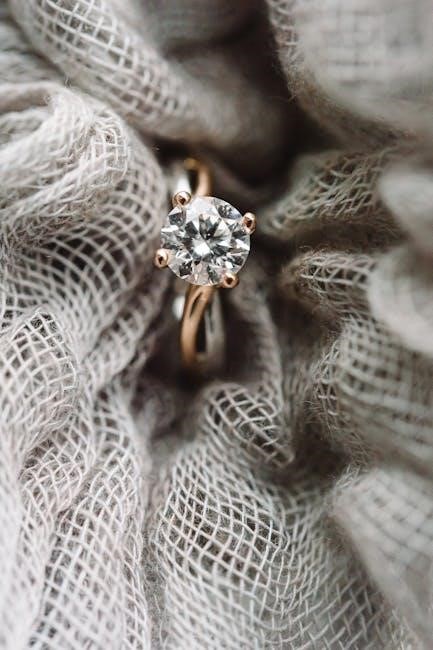Wedding rings symbolize eternal love and commitment, exchanged during ceremonies as a timeless promise. Traditionally worn on the left hand, they represent unity and devotion. With evolving styles, they now cater to diverse tastes, blending classic symbolism with modern design, ensuring a perfect fit for every couple’s unique journey.
1.1 The Symbolism and Significance of Wedding Rings
Wedding rings are profound symbols of eternal love, commitment, and unity between two individuals. Exchanged during ceremonies, they signify a lifelong promise, often worn on the left hand, believed to house the “vein of love” leading to the heart. Beyond their beauty, they represent trust, fidelity, and partnership. In many cultures, such as Germany, rings are integral to wedding rituals, with customs like the father walking the bride down the aisle; Their enduring significance lies in their timeless representation of devotion, transcending trends and styles, making them a cherished token of marriage for generations.
1.2 A Brief History of Wedding Rings
Wedding rings have ancient origins, with early examples made from materials like papyrus and leather. The Egyptians are credited with creating the first metal rings, symbolizing eternal commitment. The Romans later adopted this tradition, using iron rings for their durability. The practice of wearing rings on the left hand’s fourth finger stems from an ancient belief about a vein leading directly to the heart. Over centuries, wedding rings evolved in design, incorporating precious metals and gemstones. Today, they remain a timeless symbol of love and unity, bridging history and modernity in their enduring significance to marriage ceremonies worldwide.

Steps to Choose the Perfect Wedding Ring
Choosing the perfect wedding ring involves setting a budget, determining your style, considering durability, measuring size, and seeking expert advice to ensure a lifelong, meaningful choice.
2.1 Setting a Budget for Your Wedding Ring
Setting a budget is the first step in choosing a wedding ring. Determine how much you can afford, considering your income, expenses, and savings. On average, couples spend 2-3 months’ salary, but this varies. Factors like metal type, diamond quality, and design complexity influence costs. Allocate a specific amount for the ring, ensuring it aligns with your financial comfort. Consider additional expenses like insurance or maintenance. Stick to your budget to avoid overspending. Prioritize features that matter most, whether it’s durability, style, or craftsmanship. A well-planned budget ensures a thoughtful and lasting purchase.
2.2 Determining Your Personal Style
Determining your personal style is key to selecting a wedding ring that reflects your identity. Consider your lifestyle and preferences: classic, modern, or vintage. Think about the jewelry you already wear and what complements your daily look. For active individuals, durable metals like tungsten or titanium are practical. If you prefer timeless elegance, gold or platinum may suit you. Assess whether you prefer simplicity or decorative elements like engravings or diamonds. Reflect on current trends versus enduring designs. Your ring should mirror your personality while harmonizing with your partner’s style. Explore designs to find a balance between personal taste and lasting appeal.
2.3 Considering Durability and Maintenance
When selecting a wedding ring, durability and maintenance are crucial factors. Choose metals that align with your lifestyle: tungsten and titanium are highly durable, resistant to scratches, and low-maintenance, ideal for active individuals. Platinum and gold are timeless but require occasional polishing to maintain their luster. Consider the hardness of the metal; harder options like cobalt or palladium are more resistant to wear. For those who work with their hands, a sturdy metal is recommended. Additionally, rings with intricate details or diamonds may need more care to prevent damage. Regular cleaning and proper storage can extend the life of your wedding ring, ensuring it remains pristine for years.
2.4 Measuring Ring Size Accurately
Accurate ring sizing is essential for a comfortable and proper fit. Measure your ring size at the end of the day when fingers are at room temperature. Use a ring sizer or a string wrapped snugly around the finger, then measured with a ruler. For the best fit, consider the width of the ring, as wider bands require a slightly larger size. Some jewelers offer sizing guides or tools to ensure precision. If unsure, consulting a professional is recommended to avoid resizing hassles. Remember, the ring should feel comfortable but not too tight or loose, ensuring long-term wearability and satisfaction.
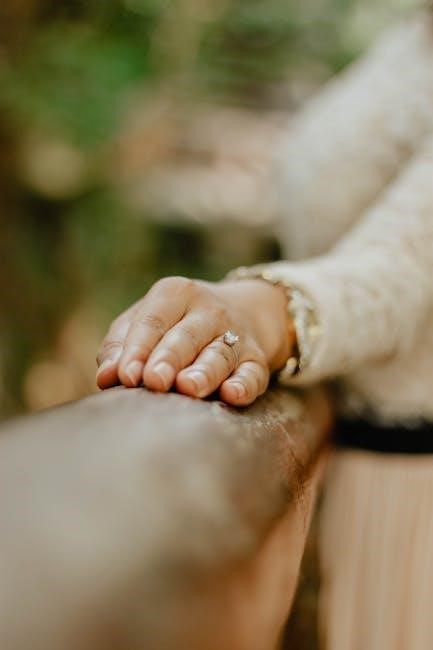
Types of Wedding Ring Materials
Precious metals like gold, platinum, and silver remain popular for wedding rings, while alternative options like tungsten, titanium, and cobalt offer durability. Each material boasts unique characteristics, ensuring a perfect match for personal style and lifestyle preferences.
3.1 Precious Metals: Gold, Platinum, and Silver
Precious metals like gold, platinum, and silver are timeless choices for wedding rings, offering luxury and durability. Gold is available in white, yellow, and rose hues, catering to diverse styles. Platinum, known for its strength and lustrous finish, is ideal for intricate designs. Silver, though less common, provides an elegant, modern look. Each metal carries emotional value, making them popular for symbolizing enduring love and commitment. Their versatility allows for customization, ensuring a perfect fit for every couple’s unique taste and preferences.
3.2 Alternative Metals: Tungsten, Titanium, and Cobalt
Alternative metals like tungsten, titanium, and cobalt are gaining popularity for their durability and modern appeal. Tungsten is incredibly hard, making it resistant to scratches, while titanium is lightweight and hypoallergenic, perfect for sensitive skin. Cobalt offers a sleek, lustrous finish and exceptional strength. These metals are ideal for active individuals and those seeking a contemporary look. They are also more affordable than precious metals, offering a stylish and practical choice for wedding rings. Their unique properties make them a great option for couples looking for a durable and distinctive symbol of their commitment.
3.3 The Pros and Cons of Each Material
Each material offers unique advantages and drawbacks. Gold is timeless and elegant but can be soft, requiring maintenance. Platinum is durable and hypoallergenic but expensive. Silver is affordable yet less durable. Tungsten is scratch-resistant but heavy; Titanium is lightweight and hypoallergenic yet difficult to resize. Cobalt combines strength with a sleek finish but lacks the scratch resistance of tungsten. Understanding these pros and cons helps couples choose materials that align with their lifestyle, budget, and personal preferences, ensuring a wedding ring that endures for a lifetime while reflecting their individual tastes.
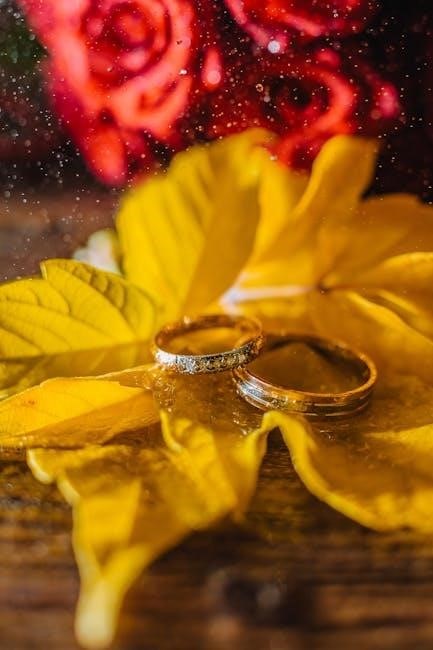
Wedding Ring Styles for Men and Women
Explore a variety of wedding ring styles, from classic bands to decorative designs, tailored for men and women. Discover sleek, durable options for men and elegant, intricate choices for women, ensuring timeless appeal.
4.1 Classic and Simple Designs
Classic and simple wedding ring designs offer timeless elegance, appealing to those who prefer understated beauty. These styles often feature unadorned bands in precious metals like gold or platinum, ensuring comfort and versatility. Their clean lines and minimalist aesthetic make them suitable for everyday wear. For men, classic designs are popular for their durability and sophistication, while women may opt for slim profiles or subtle textures; These designs are perfect for couples who value simplicity and tradition, allowing the ring’s inherent beauty to shine without distractions.
4.2 Decorative and Engraved Options
Decorative and engraved wedding rings offer a way to add personal flair and sentimental value. These designs often feature intricate patterns, milgrain details, or engravings that make the ring truly unique. Engraving allows couples to add names, dates, or meaningful phrases, creating a lasting symbol of their commitment. Decorative options may include channel-set diamonds, diamond pavé, or textured finishes, offering a touch of elegance and sophistication. These styles cater to those who want their ring to tell a story or reflect their individuality, making the piece not just a symbol of love but also a work of art that stands out.
4.3 Diamond and Gemstone Accents
Diamond and gemstone accents elevate wedding rings, adding elegance and personal style. Popular options include channel-set diamonds, diamond pavé, and vibrant gemstones like sapphires or rubies. These accents can be subtly integrated into the band or serve as a centerpiece, creating a striking focal point. Couples can choose from various settings, such as prong, bezel, or flush, to ensure durability and style. Gemstones also offer a way to incorporate birthstones or meaningful colors, making the ring uniquely personal. Whether understated or bold, diamond and gemstone accents allow couples to express their individuality and celebrate their union with a touch of brilliance and sophistication.
4.4 Men’s Wedding Ring Styles
Men’s wedding rings have evolved to offer a wide range of styles, from classic simplicity to modern designs. Popular options include bands made from durable metals like cobalt, titanium, and tungsten, known for their strength and sleek appearance. Many men prefer unadorned bands, while others opt for subtle details like engravings or channel-set diamonds. The rings often feature a minimalist aesthetic, with widths typically ranging from 4mm to 7mm. Some designs incorporate textured finishes or matte surfaces for a contemporary look. These styles cater to diverse preferences, ensuring a perfect fit for every man’s taste and lifestyle.
4.5 Women’s Wedding Ring Styles
Women’s wedding rings offer a variety of elegant and sophisticated designs, often featuring intricate details and precious stones. Popular styles include slim bands adorned with diamonds or gemstones, as well as ornate designs with engravings or pavé settings. Many women prefer delicate, dainty rings, while others opt for bold, statement pieces. The trend leans toward mixing metals, such as pairing white gold with rose gold, and incorporating personalized elements. Some designs also include matching engagement rings or eternity bands for a cohesive look. These styles cater to individual tastes, ensuring a perfect blend of beauty and personal expression.
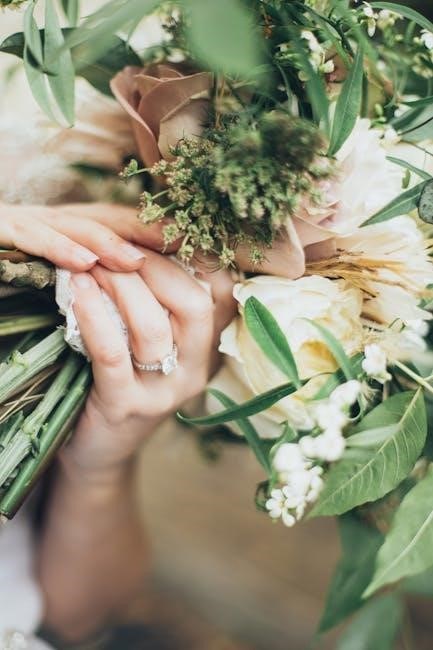
Customizing Your Wedding Ring
Customizing your wedding ring allows for personal touches, such as engravings, mixing metals, or designing a unique band. This creates a meaningful, one-of-a-kind symbol of your commitment.
5.1 Engraving and Personalized Details
Engraving and personalized details allow couples to infuse their wedding rings with unique significance. Popular options include names, dates, or meaningful symbols, creating a lasting emotional connection. Many couples choose engravable styles, adding personal touches that make the ring one-of-a-kind. Whether it’s a special message or a shared motif, these details reflect the couple’s journey and love story. Additionally, some designs offer customizable elements like mixed metals or unique patterns, ensuring the ring aligns with their personal style. Consulting with jewelers can help couples explore creative ways to personalize their rings, making them truly unforgettable and cherished for a lifetime.
5.2 Mixing Metals and Stones
Mixing metals and stones offers a unique way to create a wedding ring that stands out. Combining different metals, such as gold with platinum or tungsten with titanium, allows for a distinctive two-tone or multi-tone design. Adding diamonds or gemstones enhances the ring’s elegance and personal touch. Some styles feature channel-set diamonds or pavé accents, blending durability with sophistication. This approach ensures the ring reflects the couple’s individuality while maintaining timeless appeal. By experimenting with materials and accents, couples can craft a piece that is both visually striking and deeply meaningful, making their wedding ring a true one-of-a-kind treasure.
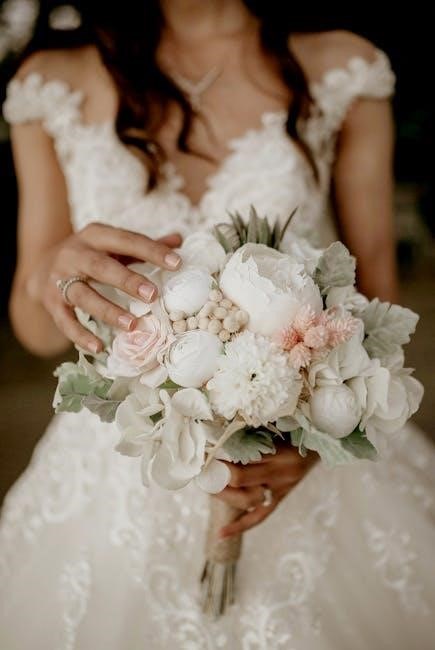
5.3 Designing a Unique Band
Designing a unique wedding band allows couples to infuse their personal style and story into the ring. From modern minimalism to intricate details, customization options are endless. Consider engravings, textured finishes, or asymmetrical designs for a standout look. Mixing materials like gold with tungsten or adding gemstones creates a distinctive aesthetic. Couples can also choose custom shapes or patterns that hold sentimental value. Whether it’s a subtle detail or a bold statement, a bespoke design ensures the ring is a one-of-a-kind symbol of their commitment. Working with a jeweler to sketch and refine ideas brings this vision to life, making it truly unforgettable.
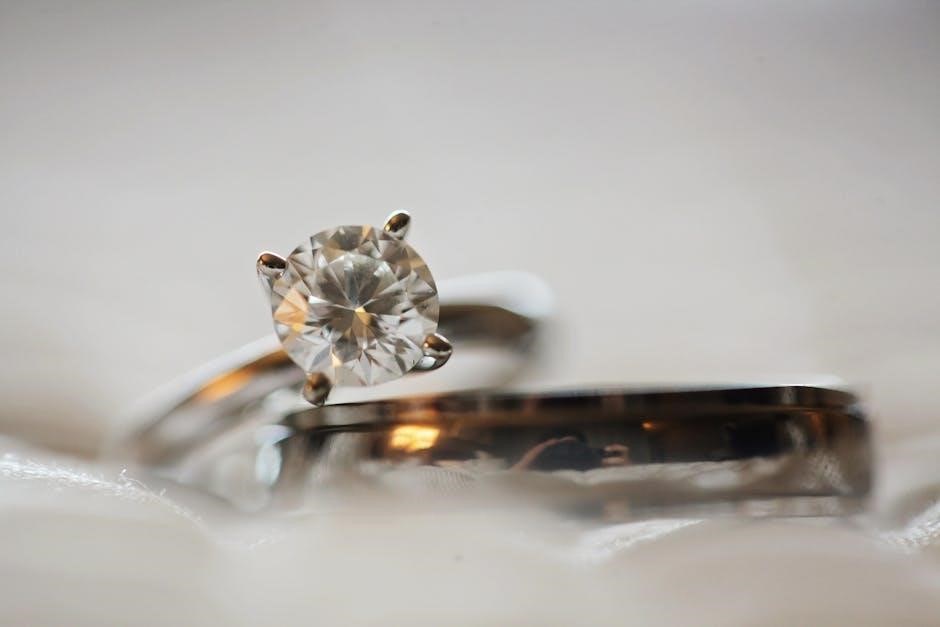
Matching Wedding Ring Styles for Couples
Matching wedding ring styles emphasize coordinating designs that share common elements while reflecting individual tastes, ensuring harmony without identical appearances.
6.1 Coordinating Designs Without Being Identical
Couples can achieve a harmonious look by selecting rings that share similar elements, such as metal type or engraving patterns, while maintaining individuality through unique details. For instance, both partners might opt for matching engravings or similar band widths but choose different metals or accents to reflect their personal style. This approach ensures their rings complement each other without appearing identical, creating a balanced and cohesive appearance that symbolizes unity and individuality.
6.2 Sharing Common Elements in the Design
Sharing common design elements, such as metal type, engraving patterns, or stone accents, creates a sense of unity while allowing each ring to maintain its uniqueness. For example, both partners might choose bands in the same metal, like platinum or gold, but differ in width or detailing. Engravings, such as a shared date or initials, can also tie the designs together. Additionally, incorporating similar gemstones or textures ensures harmony without sacrificing individuality. This balanced approach reflects a couple’s connection while celebrating their distinct personalities, making the rings both meaningful and visually cohesive.
6.3 Choosing Rings That Complement Each Other
Choosing rings that complement each other involves balancing shared aesthetics with individual preferences. While they don’t need to be identical, selecting rings with harmonious elements ensures a cohesive look. For instance, opting for the same metal type, such as platinum or gold, creates a unified appearance. Additionally, incorporating similar design features, like engravings or textured patterns, can enhance their complementary style. Couples may also choose bands with contrasting details, such as one featuring diamonds and the other a sleek, minimalist design, to reflect their unique personalities while maintaining a sense of togetherness. This approach celebrates both unity and individuality seamlessly.
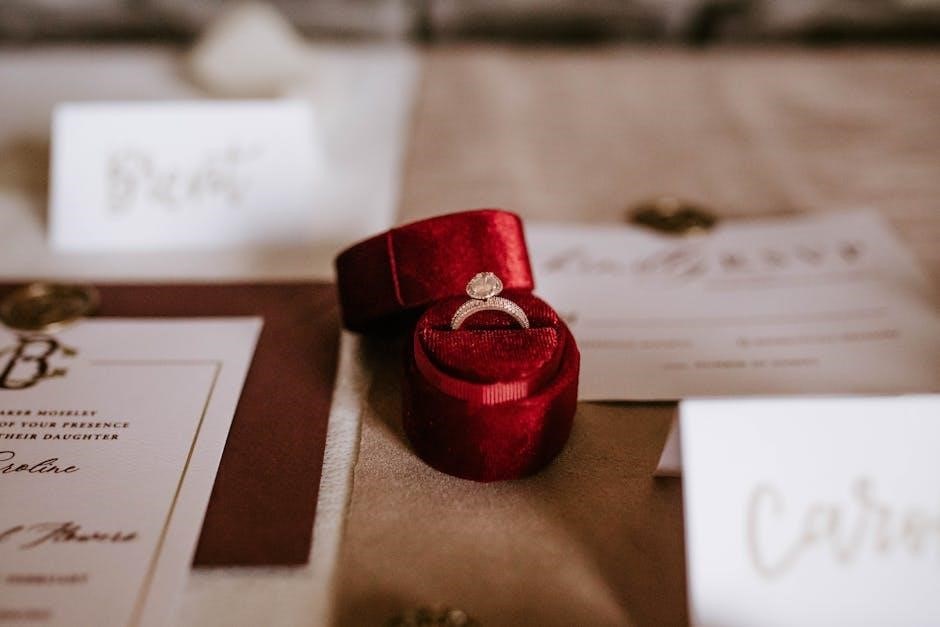
Wedding Ring Shopping Tips
Start by setting a budget and researching online or in-store options. Consider styles, materials, and diamond quality. Visit stores, seek expert advice, and measure your size accurately for the best fit.
7.1 Researching Online and In-Store Options
Researching wedding rings involves exploring both online and in-store options. Online platforms like Blue Nile and Zola offer vast collections with detailed descriptions, customer reviews, and virtual try-ons. In-store experiences provide personalized service, allowing you to try on rings and receive expert advice. Compare styles, materials, and prices across platforms to find the best fit. Online reviews and return policies are crucial for confidence in your purchase. Balancing convenience and personalization, both methods help you make an informed decision. Consider visiting stores to finalize your choice after narrowing down options online.
7.2 Understanding the 4Cs of Diamonds
The 4Cs—Carat, Color, Clarity, and Cut—guide diamond selection for wedding rings. Carat refers to weight, with larger diamonds being rarer. Color grades range from colorless (D) to light yellow (Z). Clarity assesses inclusions and blemishes, with Flawless (FL) being highest. Cut determines brilliance, with Ideal or Excellent cuts maximizing fire and sparkle. Balancing these factors ensures a diamond that suits your style and budget. Understanding the 4Cs helps prioritize what matters most, whether it’s size, quality, or brilliance, ensuring your diamond is a lasting symbol of love and commitment.
7.3 Asking for Expert Advice
Consulting with a professional jeweler is crucial when selecting a wedding ring. Experts can guide you through the process, helping you understand the 4Cs of diamonds and recommending styles that suit your preferences. They can also explain the differences in materials and settings, ensuring durability and a perfect fit. Jewelers often provide personalized recommendations based on your lifestyle and budget, making the decision easier. Their knowledge and experience can help you avoid common mistakes and find a ring that truly reflects your commitment and personal style.
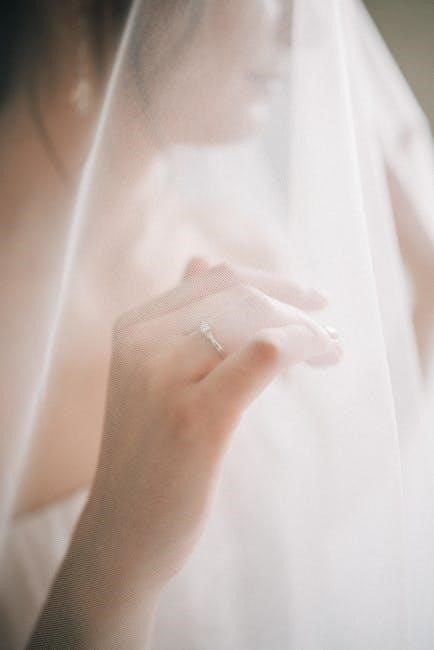
Wedding Ring Maintenance and Care
Regular cleaning and proper storage are essential to preserve your wedding ring’s brilliance. Insuring your ring offers financial security, while routine inspections ensure its longevity and beauty.
8.1 Cleaning and Storing Your Ring
Cleaning your wedding ring regularly is essential to maintain its sparkle and durability. Use mild soap and warm water for routine cleaning, avoiding harsh chemicals that may damage the metal or stones. For more thorough maintenance, consider professional cleaning services. Proper storage is equally important—keep your ring in a soft cloth pouch or padded box to prevent scratches and damage. Avoid wearing your ring during activities that could cause harm, such as heavy lifting or sports. By following these care tips, your wedding ring will remain a stunning symbol of your commitment for years to come.
8.2 Insuring Your Wedding Ring
Insuring your wedding ring is a wise decision to protect this meaningful investment. Many homeowners or renters insurance policies offer coverage for jewelry, but check the limits and conditions. Consider specialized jewelry insurance for broader protection against loss, theft, or damage. Appraisal by a gemologist may be required for high-value rings. Keep records of your ring’s value and details for claims. Insurance ensures your cherished symbol of love remains protected, giving you peace of mind. It’s a small step to safeguard an item of great emotional and financial significance for years to come.
8.3 Regular Maintenance Checks
Regular maintenance checks are essential to preserve the beauty and durability of your wedding ring. Schedule annual inspections with a professional jeweler to examine prongs, settings, and overall condition. Clean your ring frequently using mild soap and water to prevent dirt buildup. Avoid exposure to harsh chemicals or extreme temperatures. For diamond or gemstone settings, ensure they are secure. Addressing minor issues promptly prevents costly repairs. By maintaining your ring, you ensure it remains a stunning symbol of your commitment for generations. Regular care not only protects your investment but also honors the sentimental value it holds.

Wedding Ring Traditions and Ceremonies
Wedding rings are profound symbols of commitment, exchanged during ceremonies to signify unity. Their placement on the left hand varies across cultures, reflecting unique traditions and meanings, while their role in rituals remains universally meaningful.
9.1 The Role of Wedding Rings in Different Cultures
Cultural traditions greatly influence the significance and design of wedding rings. In many Western cultures, rings are worn on the left hand, symbolizing the heart’s closeness, while some Eastern traditions prefer the right. German weddings often involve the father escorting the bride, and rings may feature engravings. Some cultures incorporate religious symbols, while others emphasize minimalist designs. Across the globe, wedding rings are exchanged as vows of unity, reflecting both personal and cultural identity. These customs highlight the ring’s enduring role as a universal symbol of love and commitment, blending tradition with individual style.
9.2 Exchange of Rings During the Ceremony
The exchange of wedding rings is a pivotal moment in the ceremony, symbolizing mutual vows and lifelong commitment. Typically, the rings are blessed before being handed to the couple. The exchange often involves the bride and groom placing the ring on each other’s finger, accompanied by promises of fidelity. This act is deeply emotional, marking the union’s formalization. The ring’s placement on the left hand, particularly the fourth finger, is rooted in ancient beliefs about the vein connecting to the heart. This sacred ritual underscores the ring’s role as a tangible symbol of eternal love and partnership.
9.3 Wearing the Ring on the Correct Finger
The wedding ring is traditionally worn on the fourth finger of the left hand, known as the ring finger. This practice originates from ancient Roman and Egyptian beliefs that this finger contains the “vena amoris,” a vein directly connected to the heart. Some cultures, however, place the ring on the right hand. Regardless of the hand, the ring symbolizes commitment and is typically worn daily as a visible reminder of marital vows. Proper placement ensures the ring’s significance is honored, reflecting the couple’s enduring bond and devotion to one another.
A wedding ring is a meaningful symbol of love and commitment. By considering personal style, budget, and durability, couples can choose a ring that truly represents their partnership.
10.1 Final Tips for Choosing the Perfect Wedding Ring
When selecting a wedding ring, prioritize personal style, budget, and durability. Consider the 4Cs for diamonds and ensure proper sizing. Explore customization options for a unique touch. Balance trends with timeless designs and seek expert advice for guidance. Regular maintenance and insurance will protect your investment. Ultimately, choose a ring that reflects your love story and commitment to one another, ensuring it is both beautiful and meaningful for a lifetime.
